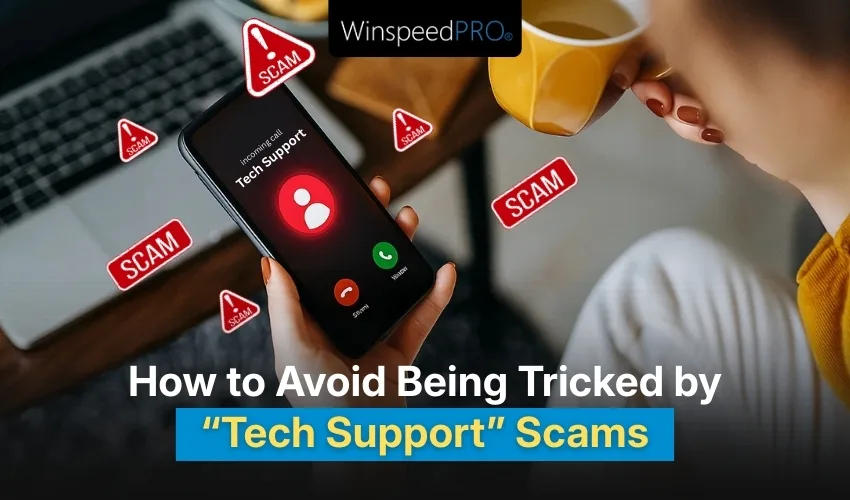How to Avoid Being Tricked by “Tech Support” Scams

How to Avoid Being Tricked by “Tech Support” Scams
Tech support scams appear out of nowhere and are among the most troubling in today’s digital world. They often target individuals who are already under stress or facing financial loss. Scammers trick both organizations and individuals into sharing sensitive information or pressuring them to make payments, usually through phone calls. To avoid falling victim, you need to stay alert and follow practical tips to handle the situation if you ever get trapped.
Tip 1: Avoid Unexpected Calls or Messages
These scams usually rely on phone calls, email, or even a text message. Avoid such a message if you didn’t reach out first. Sometimes messages may be genuine, so analyze carefully. If you confirm it’s real, respond appropriately; otherwise, ignore or close it.
Always avoid suspicious messages urging you to click links, whether for software downloads or anything else. Verify that the person communicating with you is from the official company or organization, or is a fraud.
Tip 2: Don’t Trust the Caller ID
Don’t trust a call just because the caller ID shows your provider’s name - it can be faked. With today’s technology, scammers can easily fake caller IDs to make them look authentic. Whenever you feel anything suspicious, immediately contact the company to double-check the situation.
Warning: If an individual is calling you constantly, that is another sign that scammers are trying hard to trap you.
Tip 3: Don’t Click on Random Pop-up Messages
You may receive a random pop-up message that demands technical assistance. They mostly claim that your device is corrupted with a virus and ask you to buy some random software to cure this problem. These messages are totally fake and drafted smartly. Sometimes, they call you, claiming to be from the original tech support company.
If you accidentally open a pop-up, don’t click on its links and block calls from related numbers.
Note: Remember, tech support only comes when you actually need it or there is an initiative from your side; until then, avoid falling for such tactics from scammers.
Tip 4: Never Allow Remote Access
First, scammers trick you by sending you a refund or a promise to fix an issue with your device. Then, they manipulate you and request remote access to control your computer through third-party applications. Once you let them in, they can access your data and take full control of your device. All this may fool you into sending money to the scammers or lead you to download malicious software.
Reminder: Never share your screen or provide remote access to any stranger contacting you.
Tip 5: Learn How Scammers Want to Get Paid
Tech support scammers usually demand payment through untraceable methods such as cryptocurrency, wire transfers, gift cards, or payment apps. Through these payment methods, you won’t be able to trace their locations. If anyone forces you to pay through these kinds of payment methods, then the person might be a scammer.
Tip 6: If You Feel Pressured, Don’t Act
If someone is pressuring you to act immediately, Stay Alert! Hang up or disconnect the scammer’s call immediately, then take a moment to think and verify the request. If they contact you by text, simply close and ignore the message. Don’t feel embarrassed if you have to cut their call; report the incident to your friends and family to keep them aware of this scam.
Frequently Asked Questions
How to Protect Yourself From Tech Support Scams?
Real tech support companies will not contact you first; they only respond when you reach out for help. Make yourself alert by reading these points so that you can protect yourself from tech support scams:
- If you’re unsure about a message, contact the company or institution directly using a phone number or website you’ve verified yourself.
- Keep your operating system, web browsers, and antivirus software fully updated to protect your devices from malware and other threats.
- Avoid clicking on random pop-up or error messages appearing on your display.
What Can I Do if a Tech Support Scammer Has My Personal Information?
Follow these steps if a scammer has your personal information:
- Uninstall any app or software the scammer tricked you into installing.
- If you have unintentionally given access to your device to scammers, reset all of your system passwords.
- Contact your bank or financial institution right away and make them aware of the situation.
- If you have any antivirus software, run a full scan to remove any malware.
- If you still feel unsafe, report the incident to authorities such as the FTC, your bank, or local police.
How Can You Scare a Text Scammer?
You can’t stop scammers completely, but some people try to waste their time with nonsense or automated replies to irritate them. However, this isn’t recommended. However, instead of trying to scare them, it is best to block the number and report the message to the responsible authority. Avoid interacting with the message by not clicking links or sharing personal information with any stranger. These steps are crucial to protect yourself from scams.
